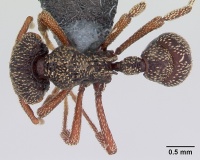Eurhopalothrix insidiatrix
| Eurhopalothrix insidiatrix | |
|---|---|

| |
| Scientific classification | |
| Kingdom: | Animalia |
| Phylum: | Arthropoda |
| Class: | Insecta |
| Order: | Hymenoptera |
| Family: | Formicidae |
| Subfamily: | Myrmicinae |
| Tribe: | Attini |
| Genus: | Eurhopalothrix |
| Species: | E. insidiatrix |
| Binomial name | |
| Eurhopalothrix insidiatrix (Taylor, 1980) | |
Workers have been collected from sifted litter.
Identification
Eurhopalothrix insidiatrix workers can be distinguished from the only other Fiji Eurhopalothrix, Eurhopalothrix emeryi, by the more reticulated and random appearance of the cephalic and mesosomal rugae.
Keys including this Species
Distribution
Latitudinal Distribution Pattern
Latitudinal Range: -16.583° to -19.05°.
| North Temperate |
North Subtropical |
Tropical | South Subtropical |
South Temperate |
- Source: AntMaps
Distribution based on Regional Taxon Lists
Indo-Australian Region: Fiji (type locality).
Distribution based on AntMaps
Distribution based on AntWeb specimens
Check data from AntWeb
Countries Occupied
| Number of countries occupied by this species based on AntWiki Regional Taxon Lists. In general, fewer countries occupied indicates a narrower range, while more countries indicates a more widespread species. |

|
Estimated Abundance
| Relative abundance based on number of AntMaps records per species (this species within the purple bar). Fewer records (to the left) indicates a less abundant/encountered species while more records (to the right) indicates more abundant/encountered species. |

|
Biology
Castes
Nomenclature
The following information is derived from Barry Bolton's Online Catalogue of the Ants of the World.
- insidiatrix. Eurhopalothix insidiatrix Taylor, 1980b: 238, figs. 11-14 (w.q.) FIJI IS.
Unless otherwise noted the text for the remainder of this section is reported from the publication that includes the original description.
Description
Worker
Dimensions [holotype, smallest para type (Suene), largest paratype (Ndelaikoro), selected by HW measurement).- TL ca 5.7, 5.5, 6.0; HL 1.42, 1.35, 1.49; HW 1.39, 1.36, 1.49; CI 99, 100, 100; ML 0.36, 0.35, 0.42; MI 25, 26, 28; SL 0.79, 0.78, 0.84; SI 57, 57, 56; maximum diameter of eye 0.14, 0.14, 0.17; PW 0.84, 0.82, 0.92; WL 1.62, 1.58, 1.80; petiolar node width 0.32, 0.32, 0.38; postpetiole width 0.72, 0.68, 0.80; gastral width 1.05, 1.02, 1.19.
Close to Eurhopalothrix emeryi distinguished from it by the following features:
1. Larger size, with relatively broad head and long scapes.
2. Sculpturation of mandibles less coarse and more extensively developed. Clypeus and front of head almost completely coarsely rugoreticulate, linear elements restricted to a few short longitudinal costae near midline, immediately behind the clypeus.
Entire pronotum, mesonotal dorsum and basal face of propodeum generally sculptured like head, with traces of longitudinal costae near midline behind pronotum. Diagonal wavy costae somewhat similar to those of E. emeryi restricted on sides of mesosoma to metepisternum and propodeum. Traces of this sculpture weakly developed in the rugosity of the mesepisternum and extreme posterior parts of the sides of the pronotum.
3. Erect specialised hairs barely differentiated at all from ground pilosity. The specimens are generally worn or encrusted with dirt or secreted material. However all hairs present in E. emeryi, except those adjacent to the eyes, seem to be represented somewhere in the series.
Queen
The Ovalau female differs from those of E. emeryi exactly as would be expected considering the worker differences listed above; notably the sculptural features.
Type Material
Type Locality: FIJI: VANUA LEVU: Suene, hololype and 24 paralypes, all workers, W. M. Mann, collected in 1915-16 (Museum of Comparative Zoology (holotype, 10 paratypes), National Museum of Natural History (12 para types), Australian National Insect Collection (two paratypes)); Ndelaikoro, litter, ca 800 m, 27.x.1977, GK (acc. 77/131), five paratype workers (New Zealand Arthropod Collection (three), ANIC (two)). VITI LEVU: Waiyanitu, three paratype workers, W. M. Mann, 1915-16 (USNM). OVALAU ISLAND: paralype deal ate female, W. M. Mann, 1915-16 (USNM). All specimens except those from Ndelaikoro are also types of Rhopalothrix (Rhopalothrix) elegans.
Some specimens in Mann's series of both E. emeryi and E. insidiatrix have lost the postpetiole and gaster. These have been reglued to the mounting points in several cases, and at least one E. emeryi gaster has been incorrectly associated with a broken E. insidiatrix specimen. This or its complement might also have occurred with specimens not seen by me.
Type Material
- Holotype, worker, Suene, Fiji, W.M. Mann, Museum of Comparative Zoology; gold-coated for SEM.
- Paratype, 13 workers, Suene, Fiji, W.M. Mann, Museum of Comparative Zoology.
- Paratype, 2 workers, Ndelaikoro, Vanau Levu, Fiji, Australian National Insect Collection.
- Paratype, 2 workers, Ndelaikoro, Vanau Levu, Fiji, New Zealand Arthropod Collection.
References
- Sarnat, E. M.; Economo, E. P. 2012. The ants of Fiji. University of California Publications in Entomology 132:1-384.
- Taylor, R. W. 1980b. Australian and Melanesian ants of the genus Eurhopalothrix Brown and Kempf - notes and new species (Hymenoptera: Formicidae). J. Aust. Entomol. Soc. 19: 229-239 (page 238, figs. 11-14 worker, queen described)
References based on Global Ant Biodiversity Informatics
- Dlussky G.M. 1994. Zoogeography of southwestern Oceania. Zhivotnoe naselenie ostrovov Iugo-Zapadnoi Okeanii ekologo-geograficheskie issledovanii 48-93.
- Sarnat Eli M. 2009. The Ants [Hymenoptera: Formicdiae] of Fiji: Systematics, Biogeography and Conservation of an Island Arc Fauna. 80-252
- Taylor R. W. 1980. Australian and Melanesian ants of the genus Eurhopalothrix Brown and Kempf - notes and new species (Hymenoptera: Formicidae). Journal of the Australian Entomological Society 19: 229-239.
- Ward, Darren F. and James K. Wetterer. 2006. Checklist of the Ants of Fiji. Fiji Arthropods III 85: 23-47.

